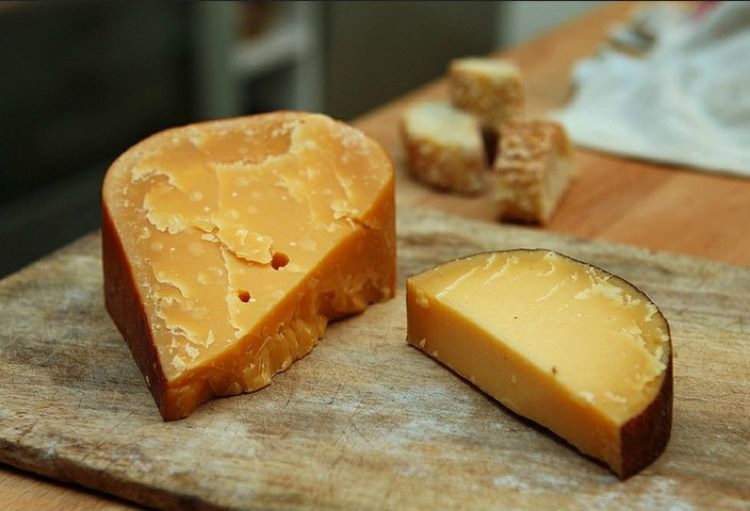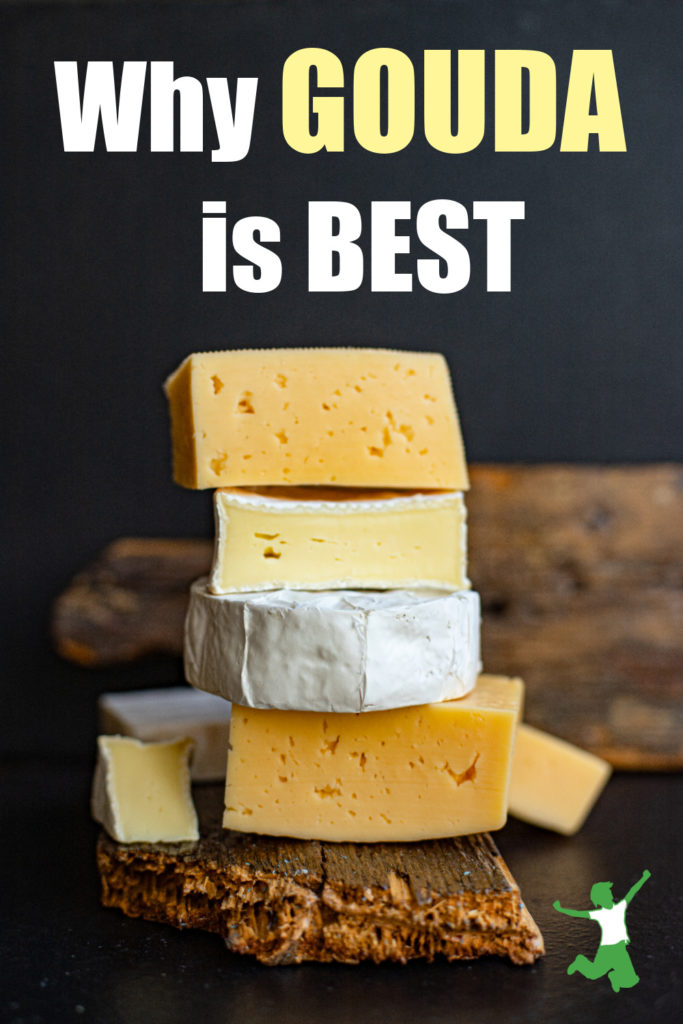Why Gouda is likely the most nutrient dense type of cheese you can buy even if you buy supermarket brands made with conventional milk.

If I was forced to choose a single cheese to eat for the rest of my life that would best maintain my health, it would be Gouda cheese.
Is Gouda my favorite healthy cheese?
Not really.
While I certainly like Gouda cheese and don’t mind eating it, my taste buds consistently rank several other cheeses quite a bit higher on the enjoyment scale such as Brie which I craved during pregnancy.
Why Gouda cheese then?
Gouda and the X Factor
You might be shocked to learn, as I was, that Gouda cheese is higher than most liver, grassfed butter, and even pastured egg yolks in the critical nutrient Vitamin K2.
This is the nutrient identified by Dr. Weston A. Price as the elusive “Activator X”.
Vitamin K2 along with the other fat soluble activators A and D are synergistically responsible for the vibrant health and extremely high resistance to aging and degenerative disease as experienced by Traditional Cultures and as described in Dr. Price’s groundbreaking book Nutrition and Physical Degeneration.
Vitamin K2 is extremely difficult to get sufficient quantities of in the diet. This is the case even if one consumes grassfed meats and dairy on a regular basis.
The reason is the worrisome depletion of our soils which grassfed farmers are valiantly turning the tide on, but which will still take several decades if not even a century or two to reverse on a widespread basis.
On top of this, many families are currently struggling to afford any grassfed meat and dairy at all.
An inflationary economy requires creative and practical solutions for the food budget. This ensures that this critical and elusive nutrient is in the diet in sufficient quantities.
This helps secure freedom from tooth decay and high immunity. Such vigilance prevents degenerative diseases like osteoporosis, cardiovascular disease, periodontal disease, cancer, and diabetes among many others.
K2 is also the vanity vitamin as it is known to prevent facial wrinkles. K2 deficiency can be written all over your face…quite literally!
Synergy with No Toxicity
Vitamin K2 has no known toxicity even at high intake levels.
However, it is most effective when consumed in the presence of the other fat soluble activators Vitamin A and D.
Therefore, getting Vitamin K2 from food is always the best way to go if at all possible.
Gouda Cheese Top 3 for Most Elusive Nutrient
This is where Gouda cheese comes in.
You see, the food that is highest in Vitamin K2 is natto, which is very difficult to find and even more difficult to consume due to its very horrible taste and texture. If you are game, you can usually find it at Asian specialty stores. Look for it in the freezer section.
Natto contains about 1,103 mcg of K2 per 3.5 ounce portion. This is more than any other food by a large margin. Note that it is best to source organic natto due to toxicity issues from GMO soybeans.
The second highest food in Vitamin K2 is goose fat particularly from the liver which has 369 mcg per 3 1/2 ounce portion.
While highly delicious and wonderful to eat, goose liver pate is very hard to find in most places. It is also a very high end, gourmet food which makes the price out of reach for most.
Rounding out the top 3 foods highest in Vitamin K2 is none other than the humble Gouda cheese. It boasts 75 mcg per 3 1/2 ounce serving! This compares to pastured egg yolks and butter, which each have about 15 mcg of K2 per 3 1/2 ounce portion.
Grassfed or Organic Not Required
Here’s the really excellent news…
Gouda cheese is extremely high in Vitamin K2 even if the milk it’s made from was not grassfed.
This is due to the bacterial cultures used to ferment milk into Gouda cheese. Bacteria produce a special type of Vitamin K2 (MK-7) which according to current research is as effective as the animal form of Vitamin K2 (MK-4) at preserving human health when combined in the diet with the other fat soluble activators A and D.
Of course, grassfed Gouda cheese would be best as Gouda made from this highest quality raw milk would be high not only in MK-7 but also MK-4, the animal form of K2.
For some, however, supermarket Gouda cheese is all they can find or afford!
In other words, Gouda cheese is high in Vitamin K2 regardless of how the milk was produced. Gouda even if made from the milk of the average grainfed, conventionally raised cow, is still very much worth it to buy from a nutritional standpoint!
Other hard cheeses would also be high in Vitamin K2, but Gouda is the highest of them all. Perhaps this is a reason why cheese is the most stolen item in the world!
Sources
Vitamin K2 and the Calcium Paradox, by Dr. Kate Rheaume-Bleue ND









Hi Sarah !
Nice post !
I wonder if the colour of old-aged Gouda has something to do with his vitamin K2 content. Look, for example : ; and cheddar is often cited as an example on comments.
For your information, in the north of France (near Lille) a french version of Gouda is made, called Mimolette ( http://upload.wikimedia.org/wikipedia/commons/thumb/f/fc/Mimolette_vieille_etuvee.jpg/280px-Mimolette_vieille_etuvee.jpg ) and it’s still orange (never seen a yellow one) ! I wonder if mimolette gets the same high content (in K2 vitamin) as Gouda does.
Wow! Did not know this! How cool! Gouda: The Nutrient Dense Cheese of Choice http://t.co/71ubbsdn #FatHeals #fb
My husband is a huge cheese fanatic! He grew up in Wisconsin. What can I say? 🙂 We buy lots of raw cheese at a local dairy, but they don’t have Gouda. So we picked some up at Sam’s Club today and YUM! I don’t think I’ve eaten it before. I’m pregnant, so I’m glad to see it’s considered safe for pregnancy. I’m also taking CLO, so I’m getting that A&D as well. Thanks for all the info you post!
When I looked at the book on Amazon there was a link to Jarrow’s Mk-7 derived from Natto. What is your opinion on this?
Great article. After reading Kate Rheaume-Bleue’s book and reading this, I’ve come to the anecdote that being from the Netherlands, Gouda may have helped make the Dutch the tallest people in the world. As K2 is critical in the management of calcium transport and distribution to bones, it seems that a nation that has an abundant supply of K2 in their diets can grow so tall. All anecodotal but the puzzle pieces do seem to fit. Now, off to Trader Joe’s for some Gouda for my kids!
Sorry Sarah, I just can’t buy it. I understand the biochemistry of milk, how to make cheese and this doesn’t make sense to me. First of all if the milk is pasteurized prior to making the cheese the vitamins and enzymes in the raw milk are killed, milk that is pasteurized is dead. Unlike what was expressed by one follower, adding the bacteria doesn’t produce vitamins or enzymes to pasteurized milk but rather adds the lactic bacteria that the milk requires in order to make the cheese. As I said anyone who does make cheese, and many of us do, understands, the bacterial culture to make all of these various cheeses could be the same, methods differ. I cannot imagine that K2 is a product of the addition of lactic bacteria, but that it does exist in cheeses made with pastured grass fed milk.
Sounds like you need to read the book as it goes into this in detail. Even in pastured raw cheese, there is very little MK-4 (the animal form of K2) compared with MK-7 from the fermentation bacteria. Most of the K2 in cheese is from bacteria which is why even pasteurized cheese is a good source of this nutrient.
I should also add that I have changed my cheese buying habits because of this information focusing much more on the hard, aged cheeses than before. Soft cheeses are much lower in K2. Gouda is the king of K2 in cheese however.
Just to double check, I opened the book and looked at the chart of foods highest in K2 again. Hard cheeses (Gouda) is #3 and 94% of the K2 in Gouda comes from bacteria (MK-7 and other MKs) while only 6% comes from animal form of K2 (MK-4). It doesn’t say if the milk was grassfed or not, but I’m presuming it must be else there would be little to no MK-4 in there at all.
Ok even giving the fact that we agree fermentation produces K2 and not the milk itself, although having been a big proponent of pastured cows and raw milk for over a decade I still have issues with that, the fact is that the method for making Edam for instance, is the same as Gouda. Also there are other hard cheeses that are made with a similar method and temperature range, havarti for instance. And cheese that is aged 60 days, fermentation is complete at that point, can really all made with the same bacteria, (Debra Amrein- Boyes 200 Easy homemade cheese recipes) why is gouda different? One pot of milk makes cheddar and one makes gouda, the milk comes from the same cows, both are inoculated with the same lactic bacteria and the aging (fermentation) is the same before you eat them, actually because of the mesophilic bacteria they both have very similar temperature ranges too…. Incidentally I picked two cheeses that are different methods, one washed curd and one cooked curd, but really there are only 5 or 6 ways to make every cheese in the world… and then the recipes are tweaked just a bit or they come from another country and are called something else….. do you see why this doesn’t make sense to me?
Gouda, gouda, gouda…..love this cheese!!! Gouda: The Nutrient Dense Cheese of Choice http://t.co/6bHWtsxw
We have been making cheese for over 10 years from our pastured cow’s milk. We make many different varieties and gouda is one. However the one thing that confuses me about this is that although the ‘method’ of making these different cheeses; cheddar, havarti, gouda, colby etc is different the bacterial culture used in them is basically the same strains of meso culture. How can gouda be that different? Also I would really like to know where I could find the research about this. thanks
The source for this article is the recently published book on K2 and the Calcium Paradox (see link above).
Do we need to be concerned about possible rbst in regular gouda cheese, as well as other undesirables that are in conventional milk?
I would like to recommend Gouda cheese from Boar’s Head. It’s imported from Holland and it has a very balanced flavor like artisan cheese. ( I live in Florida and Publix stores carries it in the Deli section ) It’s absolutely delicious! Thank you for your wonderful site. Have a Blessed New Year! =)